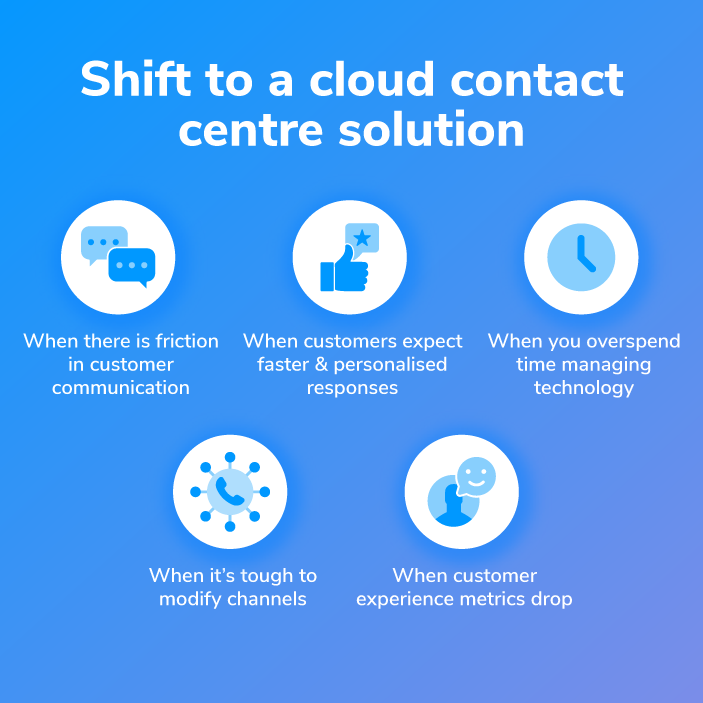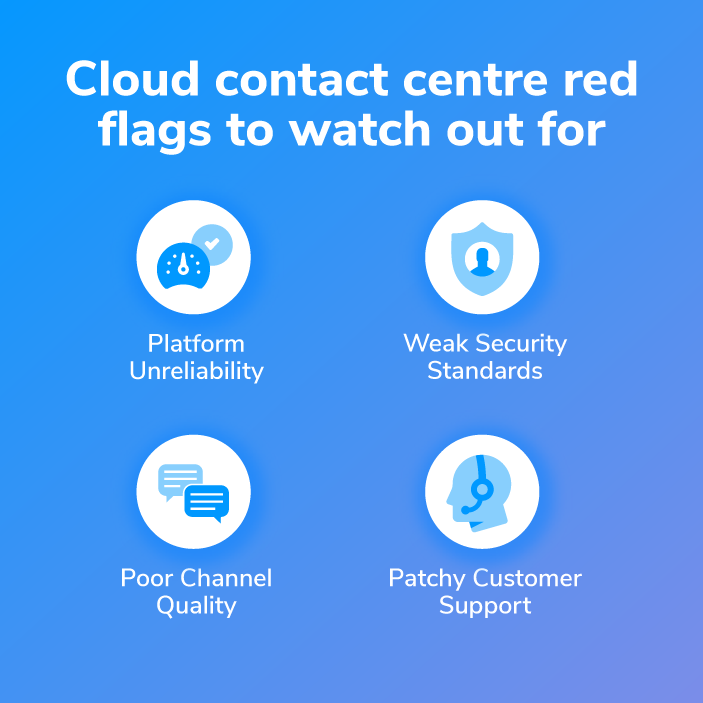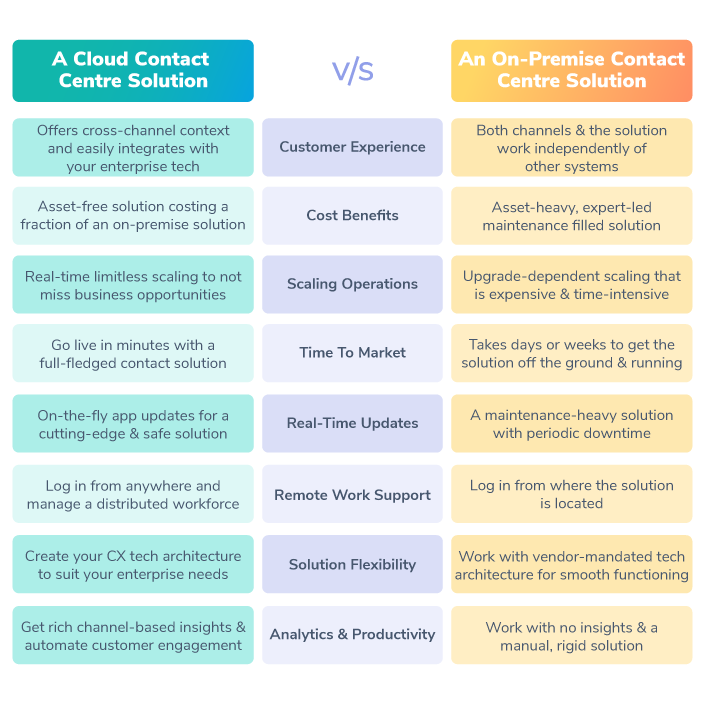The pandemic forced companies to move to a cloud communication solution to ensure business continuity. While many businesses made the switch easily, some are still finding it difficult to let go of their existing investments in on-prem PBX solutions.
The question they ask themselves is – “What happens to all the investments we’ve already made in our PBX phone system?”
However, the real question you should be asking is, “How many potential and existing customers am I going to lose because of not becoming cloud-first?”
Table of Contents
- Are you managing with an adapted on-premise solution?
- When is it time to switch to a cloud contact centre solution?
- Why does it matter to your business?
- What to be wary of while choosing a cloud contact centre solution
Are you managing with an adapted on-premise solution?
To avoid their on-prem equipment going to waste, many businesses are using workarounds, mostly via a VPN. While it is certainly possible to make things work this way, – but what is it costing you? How much time and effort are you spending trying to keep it together? And can your tech team scale it up and down at will for a seasonal sales campaign and still guarantee reliability while doing so? The answer is mostly no.
On the other hand, a native cloud contact centre solution is built to meet the complex and customised requirements of businesses like yours. It involves zero infrastructure and setup costs. Plus, it runs on the hardware available with your employees – mobile phones and a PC.
When is it time to switch to a cloud contact centre solution?

Deploying a cloud-based contact centre solution sooner than later is always a good idea. But to justify the planning and early effort to get agents aligned with making full use of it, look out for these events to know it when it is time to make the switch:
1. When there is friction in customer communication: Evolving technology offers faster, more personal, and real-time engagement. If your existing system doesn’t have the flexibility to introduce a new channel or isn’t able to manage cross-platform data, it is a good sign to look for a cloud-based contact centre solution.
2. When customers expect speed of response: Customers are aware of how rapidly services like Amazon respond to their queries. They don’t expect anything different from your service too. If your on-premise solution cannot automate aspects like auto-responding to FAQs through a chat or call flow, it might be a good time to consider switching. Or think how conversations can be auto-tagged if the solution can through a feature like call disposition. That can drive better customer experiences.
Rajkishan,
General Manager, Operations & Strategy, Swiggy
3. When you overspend time managing technology: Do you need to wait for days for your provider’s technicians to visit and modify your set of communication channels or resolve glitches that prevent smooth operators? A cloud contact centre solution offers a framework where you can manage the mix of channels suited for your business by yourself, integrate it easily with your organization’s tech stack, and more. By doing most of the tool management yourself, you cut on IT costs and reduce the time to market while the solution delivers what was promised.
4. When you can’t personalise engagement: Every channel generates crucial customer data, but it usually isn’t connected to a central data house, also called a single source of truth. This usually resides in a customer data platform (CD) or a customer relationship management (CRM) solution. If your current contact centre software cannot integrate with other customer-facing systems, that is a good sign to look for a cloud solution.
Himanshu Periwal,
VP of Growth, ixigo
Why does it matter to your business?
Here, you’ll get a detailed look at the benefits a cloud contact centre solution offers for your business:
1. Improved functionality: If your competitors are doing well, chances are their CX scores are high. A cloud contact centre solution could be key to their success, since it could offer a broader range of capabilities, including:
- Call management: Stay in control of how your customers and agents interact with each other. Set up call flows to any extent, schedule callbacks during high-volume periods, or test up-sell campaign performance with different contact numbers.
- Automation: Set up auto-responses for frequently asked questions via IVR or schedule bulk calls to your audience to engage with any new marketing or sales campaign. You can also automate feedback post-purchase to improve CX scores.
- Toggling channels: Easily introduce or retire channels like the phone, SMS, live chat, email or social media, using robust and secure APIs. That way, you keep pace with your customers’ evolving preferences.
- Tracking performance: Extract insights from your contact centre’s communication activities, especially call analytics. Understand the intent of your customers and use it to improve agent performance and offer business visibility to the management.
Sadly, an on-premise solution offers very little to none of the capabilities that come with a cloud contact centre solution.
2. Greater Cost Savings: A cloud contact centre is asset-light. You can use it with a periodic subscription, including a possible one-time implementation fee to integrate it into your enterprise stack. Even this fee is usually a fraction of what you would pay to take your existing solution live. And there are no hidden costs including maintenance or license upgradation fees.
Also, cloud contact centre vendors can auto-resolve bugs or release new features over-the-air with no effort needed by you. You get the latest version when you log in. As such, your costs will not inflate because of regular updates or changes that you make to your solution. On the flip side, an on-premise contact centre solution comes with significant maintenance costs and upgrade fees.
Kumar Vinod Sr. Manager,
Sr. Manager, Operations at Redbus
3. Auto-scalable operations: A cloud contact centre solution can scale without limits. This is especially visible when it comes to supporting customer communication during peak business periods. In a lean season, you can revert to business-as-usual and let go of added agent seats bought for the peak season.
On the contrary, an on-premise solution is not easily scalable because its operating ability depends on available hardware with you. It has a finite capacity to serve.
4. Go Live Faster: Deploying an on-premise contact centre software takes time, given the need to install the equipment, set up channels, and get the software configured. In a nutshell, what you see is what you get. Hence, it comes at a price: poor customer satisfaction as your agents toggle a bunch of apps. Launching a cloud contact centre solution involves just signing the contract and receiving administrator logins. In under a few hours, you can configure a support centre to begin engaging with your customers.
Saurabh Kochhar,
Co-Founder & Managing Director, Printvenue
5. Updates In Real-time: Customer communication with brands is rapidly evolving, with the rise of self-service channels complementing traditional ones. To keep your business agile and in tune with customer expectations either during the sales or support journey, a cloud system is a great bet. The nature of the cloud allows any number of apps or solutions running on it to be up-to-date as soon as they are made live with no tooling involved on your account.
On the contrary, updating an on-premise solution takes experts from the contact centre provider’s team to visit, retool, test, and take it live. This is cumbersome and cripples your customers’ pace of doing business with you.
6. Work From Anywhere: Remote working is the current, not new normal, as business operations evolve in the current times. A cloud contact centre solution perfectly allows you to switch to a fully remote setup if your business needs it overnight. The only computing requirements are internet-enabled laptops or mobile phones for your sales or support agents to take and place calls from the comfort of their homes. However, if you adapt the on-premise solution to operate with a remote workforce, it would suffer from its limitations – the need for regular on-site maintenance, cost of upgrades or reconfiguration, and more. It creates ripple effects that hurt your business.
Linekar Lawrence,
Network and system administrator, Zerodha
7. Solution Flexibility: A cloud-based contact centre solution usually works with existing enterprise systems, integrating with your CRM or helpdesk via Application Programming Interfaces (APIs). Think of APIs as virtual wires between your suite of tools. There are two-fold benefits here. On one hand, users find it convenient to use an integrated solution versus toggling between say, a CRM and a cloud telephony apps. On the other hand, it can centralise data through the helpdesk or CRM app for contextual customer insights.
An on-premise solution like PBX telephony offers very little scope to work with any new enterprise tool that you bring into your business or accommodate a new channel. That handicaps the full extent of what a modern solution should offer.
8. Analytics & Productivity: Compared to an on-premise contact centre which offers no insights into customer engagement across channels, a cloud contact centre solution tracks key parameters around calls or chat conversations. The solution also comes with features like call disposition that can auto-tag or allow agents to tag outcomes of calls. Such capabilities can allow agents to easily establish the context of conversations to drive future personalised engagement. Also, supervisors can track the performance of customer calls, like calls abandoned at any IVR level or customer satisfaction rates for chat conversations. Use a cloud contact centre solution to improve productivity and surpass your CX goals.
Vikas Gulati,
Product Manager, CTO, SquadRun
What to be wary of while choosing a cloud contact centre solution

You can find a host of cloud contact centre solution providers in the market, including us, that can deliver on their promises on any given day. But maintaining SLAs on a bad day, when for instance, a hack or a sudden period of demand occurs, is a different story altogether. Find a solution with a track record of flying unaffected through turbulent times during your business journey:
1. Platform Unreliability: Verify customer testimonials of cloud contact centre providers around how service uptime was maintained even when a regional data centre went down or you had a sudden inflow of customer calls.
2. Weak Security Standards: Find a provider who offers the best PCI-DSS, ISO or related security protocols to ensure data is protected while it resides in the cloud or is transmitted between applications. Note if the provider’s cloud partner complies by default with all regional data and security standards to avoid legal consequences later on.
3. Poor Channel Quality: This becomes important for channels like voice calls or text. Find a reliable partner with a proven record of high call success and voice quality rates or low latency and text delivery rates in connecting conversations.
4. Patchy Customer Support: Having an available agent when it matters the most can mean the difference between creating a lifelong customer, versus compromising on lifetime value. Shortlist highly-rated cloud providers so you can count on them at any time.
Raju Pardeshi,
Founder & CEO, BookRyde
Patching an on-premise solution in the age of remote or hybrid working that we are all getting used to is a temporary fix. There are a number of stories where customers have switched to a cloud contact centre solution overnight, and are not looking back to their earlier setup. Get this remote working guide for your sales and support team operations to make the shift.
And if you need to enquire about the kind of contact centre solution that would fit your business needs, our experts are happy to talk to you. Contact them here.







 +65-6951-5460
+65-6951-5460 +91-8088919888
+91-8088919888 +1-(718) 354-8866
+1-(718) 354-8866 +62-215-098-4960
+62-215-098-4960 +60-3-2771-2799
+60-3-2771-2799 +61-2-8073-0559
+61-2-8073-0559
No Comments